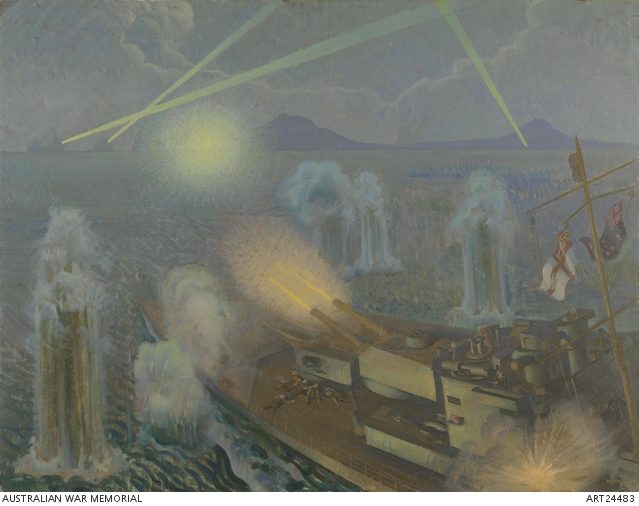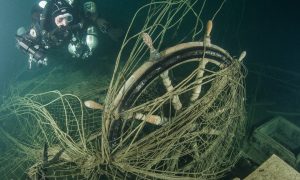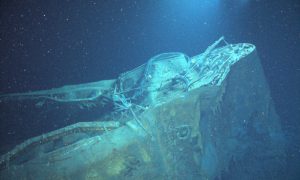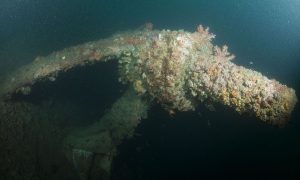In late 2013, authorities made a terrible discovery – one that threatened to further derail an already stretched relationship in the middle of the Australia–Indonesia spying scandal.
The revelation that an Australian warship, sunk in Indonesian waters during World War II, was being commercially salvaged for scrap metal was met with distress and anger in Australia. Not only was the integrity of the wreck at stake: over three hundred Australian lives had been lost when the ship sank. Their watery graves, protected by the ocean for over 70 years, were now being systematically destroyed.
But there may yet be a happy ending to this story – and from the most surprising of quarters. Since 2013, the wreck of HMAS Perth has become the centrepiece of an ambitious and deeply symbolic program of cultural diplomacy, and a model of collaboration.
The fight for Java
This story, of a war-time tragedy redeemed by international cultural diplomacy, began in February 1942. Parts of Kalimantan, Sulawesi, Sumatra and Timor were already under Japanese occupation, and the only defence against the impending Japanese invasion of Java was a motley fleet of fourteen ships from four different navies, known as American-British-Dutch-Australian (ABDA) command.
The battle that took place on 27 February 1942 between the Japanese and the ABDA forces later gained infamy as the Battle of the Java Sea. It constituted a major defeat for allied forces: of the 14 ABDA ships, all but two – HMAS Perth, with a crew of around 680, and USS Houston, whose crew numbered around 1060 – sank or retreated. The following day, the Japanese made landfall in Java, and altered the course of Indonesian history forever.
HMAS Perth and the USS Houston sailed to Tanjung Priok, north Jakarta, low on fuel and ammunition, and burdened by the knowledge that the battle for Java was lost. There was no opportunity to restore their depleted stocks before orders were received to sail towards South Java. Before departure, HMAS Perth’s mascot, a kitten called ‘Red Lead’, made a last-ditch attempt to abandon ship. The crew saw this as a bad omen, and they were right.
As they entered the Sunda Strait on 28 February, the ships were ambushed by Japanese naval forces. HMAS Perth was hit by torpedoes and sank shortly after midnight. USS Houston succumbed shortly thereafter. Between the two ships, over 1000 lives were lost. Those who survived were taken as prisoners of war, and endured years in Japanese war camps.

Murray Griffin, H.M.A.S. Perth fights to the last, 28th February, 1942, oil on hardboard, 63.4 x 81.9cm. Australian War Memorial
Diving deep
The fate of the ships was unknown for nine months and it wasn’t until the end of the war that the few surviving prisoners of war returned to Australia and the US to tell their stories.
The wrecks lay undisturbed for decades, until advances in underwater exploration led to their re-discovery in the late 1960s. Readily accessible to divers at a depth of around 35 metres, the wartime legacy of these ships sat uneasily with their increasing popularity as tourist dive sites. Souveniring was common, especially among descendants of the crew, who felt a special connection to the ships.
But in 2013, these same divers began to report the presence of a large crane on-site, equipped with a salvage claw. Commercial barges were also seen in the area, laden with corroded scrap metal. Regular visitors were well-positioned to report on the extent of the salvaging, noting significant differences to the wrecks between dive seasons. Video footage suggested that much of the ship’s superstructure – including the bridge, the guns from the upper turrets and much of the deck – had been removed.

Schools of fish around HMAS Perth, 2011. Image: Andrew Fock.
The destruction prompted a public outcry in Australia. With the bilateral relationship already under a great deal of pressure, questions were asked about what Indonesia was doing to protect Australia’s war dead. Under customary international law, HMAS Perth remains under the jurisdiction – and hence protection – of the Australian government, even though it lies in Indonesian waters. But although its crew, along with that of USS Houston, are immortalised at the Shrine of Remembrance in Melbourne, neither wreck is an official war grave.
To make matters even more complicated, Indonesia, Australia and the US have failed to sign the 2001 UNESCO Convention on the Protection of the Underwater Cultural Heritage, which affords protection to warships against looting and destruction.
From the military to the museum
Since reports of the destruction of the wrecks were first made public, the Royal Australian Navy and its Indonesian and US counterparts have worked together to survey, assess and document the sites. But while this trilateral cooperation provided opportunities for training and relationship building, the navies could only go so far in protecting and preserving the wrecks.
It was at this point, in early 2014 that a number of cultural institutions, including the Australian National Maritime Museum (ANMM), stepped in. Under the guidance of its director, Kevin Sumption, the museum is now spearheading engagement with heritage agencies in Indonesia. Its long-term objective is to have HMAS Perth heritage listed under Indonesia’s Law No. 11 of 2010 concerning Cultural Conservation.
Working collaboratively with the Pusat Penelitian Arkeologi Nasional (National Archaeological Centre of Indonesia), Sumption appreciates the enormity of the task ahead – at present, nothing has been listed under this legislation. He is cautious about their chances of success, and emphasises the importance of education and awareness-raising in minimising further damage to the wrecks.
In the meantime, with the first team of ANMM underwater archaeologists due to dive, survey and document the site in early 2016, the crew of HMAS Perth, and their kitten, are finally getting the attention they deserve.
***
This article was first published in Inside Indonesia.
 Facebook
Facebook  Twitter
Twitter  Soundcloud
Soundcloud  Youtube
Youtube  Rss
Rss 


